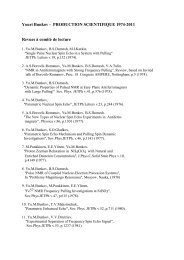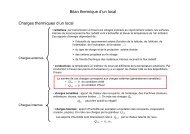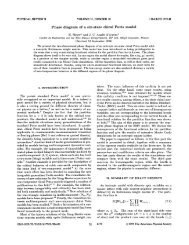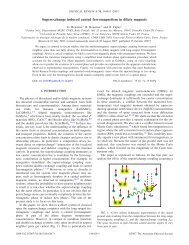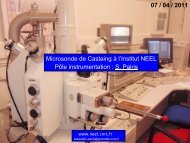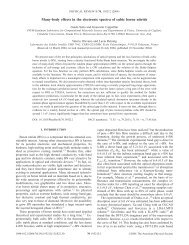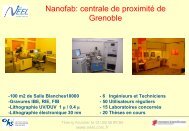Activity Report 2010 - CNRS
Activity Report 2010 - CNRS
Activity Report 2010 - CNRS
You also want an ePaper? Increase the reach of your titles
YUMPU automatically turns print PDFs into web optimized ePapers that Google loves.
MEDICAL<br />
APPLICATIONS OF THE<br />
NANOBIOSCIENCES<br />
SCIENTIFIC REPORT<br />
FURTHER READING:<br />
Optical Materials (2011)<br />
Development of a non-linear optical<br />
microscope for real-time measurement of<br />
neuronal activity in sub-micrometric<br />
structures<br />
Fig. 2: Principle (top) and realization (down) of<br />
the formation of lipid bilayers by bringing<br />
together two nanodroplets covered with<br />
phospholipids.<br />
In <strong>2010</strong>, the team already demonstrated<br />
the formation of a lipid bilayer, as shown<br />
by the large increase of capacitance.<br />
Furthermore, incorporation of hemolysin,<br />
a pore-forming protein, in the bilayer<br />
membrane results in current steps<br />
characteristic of single molecule activity.<br />
This device will therefore offer an<br />
alternative to electrophysiological “patchclamp”<br />
methods using microelectrodes -<br />
a process which is difficult to miniaturize<br />
and automate.<br />
Second harmonic imaging<br />
of potentials in nanoscale<br />
neuronal structures<br />
“New comers” Project 2007: Julien<br />
DOUADY (LIPhy)<br />
Post doctoral fellow: Hartmut WEGE<br />
The electric activities of neurons trigger<br />
neurotransmitter release at synapses that<br />
are small structures of about 200 nm. In<br />
order to measure individual synapse<br />
activation, neuroscientists use voltage<br />
dependent fluorescent dyes. In this<br />
project, such a series of dyes suitable for<br />
two-photon activation has been<br />
synthesized by the ENS-Lyon “Chemistry<br />
for Optics” group. The Motiv group at the<br />
LiPhy has built a custom two-photon<br />
microscope to image neuronal activity<br />
within brain slices, with a radial<br />
resolution of about 340 nm (Fig. 4). To<br />
address the actual challenges in<br />
neurosciences, the sensitivity of the<br />
setup will be improved to allow imaging<br />
at about 2 kHz.<br />
In the future, cell communication and<br />
potential propagation within a brain slice<br />
or cultured neurons will be studied.<br />
Thanks to this ongoing multidisciplinary<br />
project, the Grenoble neurophysiologist<br />
community now possesses a new<br />
powerful instrument to study neural<br />
networks, either in micropatterns or in<br />
brain slices.<br />
Fig. 3: recording of -hemolysin activity<br />
reconstituted in the Nanobiodrop device, the<br />
15 pA current increase represents the<br />
incorporation of one active protein molecule in<br />
the bilayer.<br />
28<br />
Fig. 4: Two-photon fluorescence imaging of<br />
pyramidal neurons located 70 µm inside in a<br />
300 µm thick sagittal slice of the mouse<br />
cortex, stained with a voltage sensitive dye.<br />
Note that the interspacing glial cells are not<br />
stained. Barscale: 10 µm



